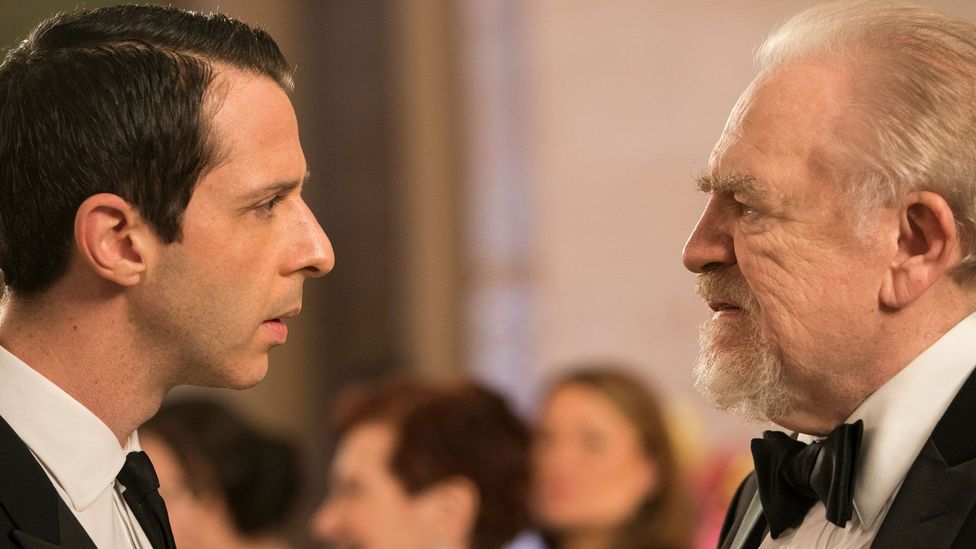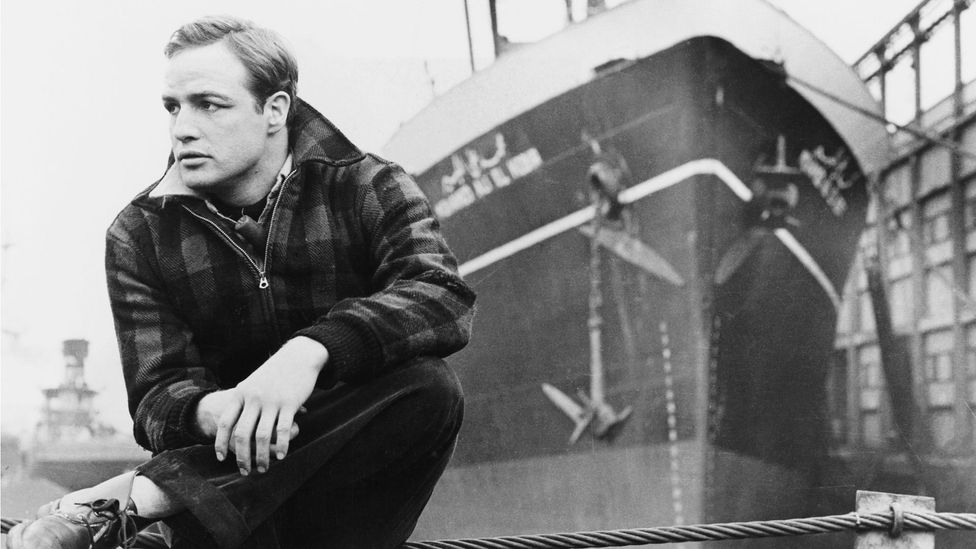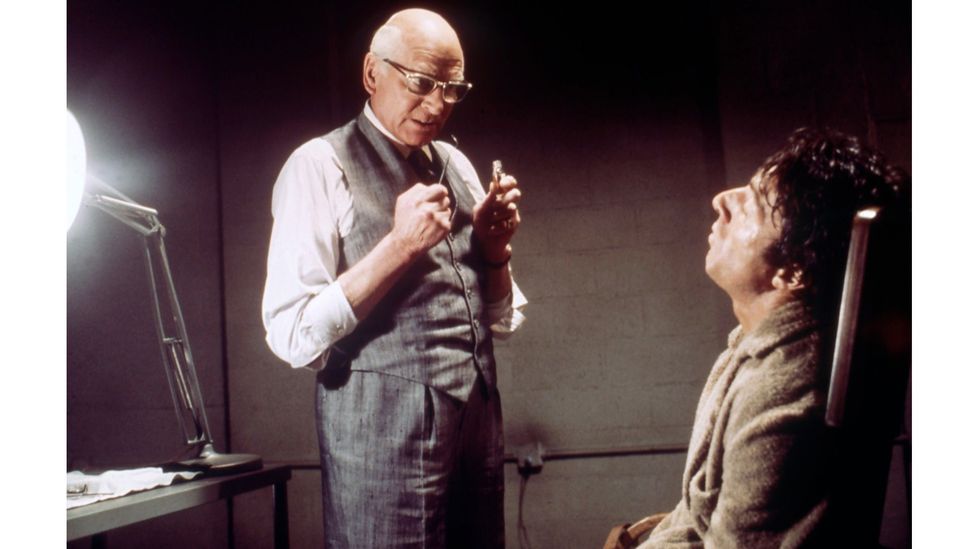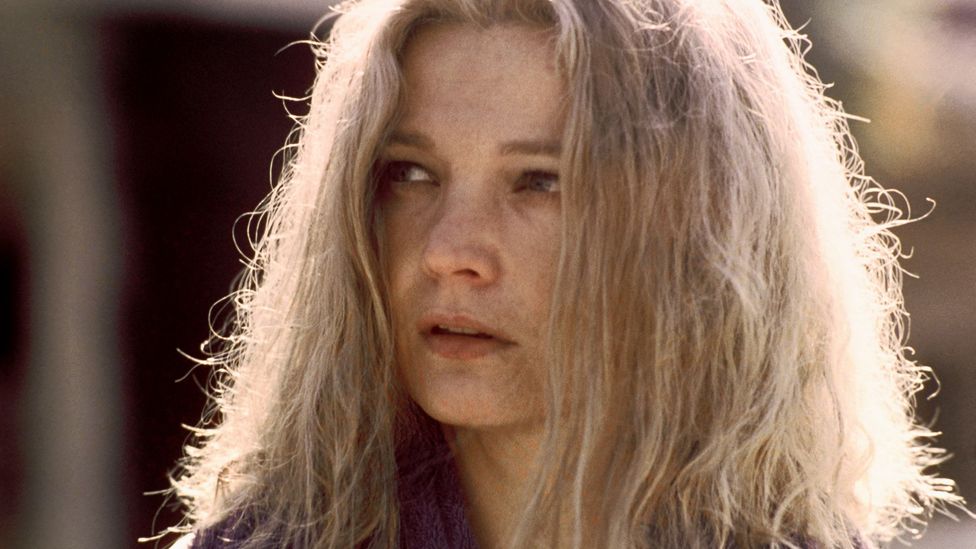Hollywood’s most extreme actors

No acting technique raises more eyebrows than method acting – commonly misunderstood these days to mean the style of performance where people go to extreme lengths to identify with their characters, or “get in their head”.
More like this:
– Succession’s “jaw-dropping finale”
– The trouble with actor makeovers
– Is Tom Hanks one of the last great movie stars?
It’s been in the headlines once again ahead of next week’s premiere of the fourth and final season of Jesse Armstrong’s eviscerating dramedy, Succession, thanks to renewed discussion around the divisive acting of one of its stars, Jeremy Strong. Ever since Strong discussed his tortured process for playing would-be media mogul Kendall Roy in an infamous 2021 New Yorker profile, he has been saddled with the “method actor” label. “I think you have to go through whatever the ordeal is that the character has to go through,” he told the magazine. He also admitted to isolating himself from his castmates, and sometimes refusing to rehearse because he wanted “every scene to feel like I’m encountering a bear in the woods”.

Succession co-stars Jeremy Strong and Brian Cox have publicly spoken about having very different attitudes to performance technique (Credit: HBO/Sky)
To say his acting technique has been unpopular with his coworkers is an understatement. Castmates Kieran Culkin and Brian Cox both articulated their concern in the same article, despite what Cox described as the “tremendous” results the method had delivered. “I worry about the crises he puts himself through in order to prepare,” said Cox. “I’ve worked with intense actors before. It’s a particularly American disease, I think, this inability to separate yourself off while you’re doing the job.”
Recently, the classically trained Cox, who plays Strong’s formidable father Logan Roy in the series, has been reiterating his distaste for Strong’s extreme, often antisocial technique. He puts it down to the differing sensibilities between British and US performers. “It’s really a cultural clash,” the Scottish actor told Variety in an interview last week. “I don’t put up with all that American s***. I’m sorry. All that sort of ‘I think, therefore I feel’. Just do the job… Don’t identify.”
Despite the criticism, Strong has doubled down on his way of working. “Am I going to adjust or compromise the way that I’ve worked my whole life and what I believe in? There wasn’t a flicker of doubt about that,” he told GQ this year. “I’m still going to do whatever it takes to serve whatever it is.”
What is method acting?
His contentious approach is the latest example of method acting causing controversy. Going “method” is typically seen as giving actors tacit consent to become their most antisocial and obsessive selves, so it’s no wonder many stars continue to call it out: those who have had strong words to say on the subject range from Toni Collette to Mads Mikkelsen. Certainly, method acting has become a catch-all term for actors going to uncongenial lengths to bring authenticity and realism to their roles. However, just as Strong does not consider himself a method actor, as he told The New Yorker, it’s important to differentiate the broad-brush conception of method acting in the public consciousness from the specifics of “The Method”, argues Isaac Butler, critic, theatre director and author of The Method: How the Twentieth Century Learned to Act.
“People usually mean that they went deep into the research and never broke character on set,” Butler tells BBC Culture. “Maybe they bought their own costumes and props and brought them with them. They wanted things to be as close to real life as possible – that’s not The Method.”
Method acting with a capital “M” is a series of inner techniques that use relaxation, and sensory and emotional exercises, as “a way of digging deep into the self in all of its idiosyncrasies and complexities to find the materials to make a character,” says Butler. “To create a reality that they can live within as the character”. There is in fact no one exact method to this naturalistic approach to acting but The Method is mainly associated with mid-20th-Century US director and acting coach Lee Strasberg – his institute once trademarked the name – who himself had been influenced by his peers Stella Adler and Sanford Meisner, as well as the forefather of naturalistic acting, Russian actor and director Konstantin Stanislavski. Stanislavski developed the idea of “perezhivanie” which, Butler writes, roughly translates to “re-experiencing”, and “occurs when an actor is so connected to the truth of a role, and has so thoroughly entered into the imaginary reality of the character, that they feel what the character feels, perhaps even think what the character thinks”.

Marlon Brando was one of the stars who ushered in a more naturalistic acting approach in Hollywood films (Credit: Getty Images)
As part of his so-called “system”, Stanislavski developed the concept of “affective memory”, whereby an actor would use “the sensory details of an intense emotional experience” to draw on those emotions in a controlled way for a scene, says Butler. Think of it like the Pixar movie Ratatouille; when the food critic Anton Ego tastes the titular dish, it triggers a happy childhood memory of the comfort of his mother’s cooking. With affective memory, rather than relying on physical stimuli, the actor would aim to recall that taste, smell or sense, to re-experience the emotions of that memory, and use it to portray their character’s similar emotional state in the required moment on stage or screen. “The actor doesn’t fully become the character, that would be impossible,” says Butler. “But the actor and the character instead meet so the actor’s reality and the character’s reality blend together”.
When members of Moscow Art Theatre introduced an early rendering of Stanislavski’s system, focused on psychological training, to the US in 1923, it proved controversial. While Strasberg made affective memory a core principle of the process within his Group Theatre collective in the 1930s, renaming it “sense memory”, Adler, a member of Strasberg’s group before becoming an acting coach in her own right, wasn’t as enamoured with the results. In 1934, Adler actually trained with Stanislavski in Paris in an updated version of his system because his earlier techniques had caused her anxiety as an actress. Rather than drawing on personal experiences and memories, Stanislavski taught her to create them using her imagination within a scene’s given, sociological circumstances.
By 1947, The Actors’ Studio was founded in New York by Elia Kazan, Cheryl Crawford, and Robert Lewis, and there, both Adler and Strasberg taught their differing methods with input from these founders. With TV shows shooting in the city, and Kazan commanding respect as a director across stage and screen, during the 40s and 50s the Studio became a “creative powerhouse”, says Butler. “Your whole career could be made there and you’re getting this amazing training, unlocking your emotional depths.”
Actors like John Garfield, who had been part of the Group Theatre collective, were already deploying Method techniques in film before the rise of the Actors’ Studio, but it was with the ascent to stardom of Studio alumni like Montgomery Clift, James Dean and Marlon Brando that method acting really became flavour of the month. Delivering human, viscerally charged performances in the likes of The Search (1948), Rebel Without a Cause (1955), and On the Waterfront (1954), respectively, these men unlocked a fragile masculinity in their troubled characters.
Certainly in the case of Brando, though, The Method specifically was not his method. “Strasberg liked to claim credit for people,” says Butler. “He claimed credit for Brando who hated him.” Adler was Brando’s teacher, in fact, and helped him harness the required emotional nuances for any given scene as dictated from the script, rather than delve into his own psyche. But with his matinee-idol looks and rugged magnetism, the actor’s screen presence revolutionised Hollywood, and certainly ushered in a more naturalistic approach to cinematic performance that has been, rightly or wrongly, aligned with The Method ever since.
Despite common misconceptions, though, great acting existed long before method acting materialised. “The obsession with method is also a misunderstanding of Hollywood film history,” Vulture critic Angelica Jade Bastién tells BBC Culture. “People use it as a way to demarcate, ‘oh, this is when acting really started in film’. There was a lot of really fascinating acting, pre-1950. Bette Davis remains untouchable, and she wasn’t a method actor.”
Davis was the opposite of a method actor: known for her intense delivery, she exaggerated her body and voice to portray the fluctuating emotional state of her characters with power and dignity. Even as the 1970s New Hollywood era favoured gritty realism, she understood her imagination was her most reliable fuel. “This film is a new experience for me,” she said of the 1972 film Madame Sin. “For one thing, it’s a crime fantasy, and usually I like to find some way of relating to my characters. But how can you relate to someone as outrageous as Madame Sin? So I have to invent all the time. It’s fun.”

The story of Dustin Hoffman and Laurence Olivier working together on Marathon Man (1976) has become symbolic of the clash between classic and method acting styles (Credit: Alamy)
Still, with the likes of Al Pacino, Robert de Niro and Dustin Hoffman training with the Actors’ Studio in the 70s, a new generation of stars renewed Hollywood’s commitment to method acting. Hoffman, for example, lost 15lbs and ran up to four miles a day to get into shape for playing a PHD student and would-be marathon runner Babe in the acclaimed Nazi-espionage thriller Marathon Man (1976). When a scene called for his character to be out-of-breath, Hoffman would run half a mile before shooting so his exhaustion would be realistic. In the film, Babe finds himself on the wrong side of Nazi war criminal Dr Christian Szell, played by the classically trained thespian Laurence Olivier. The legendary story goes that when Olivier heard Hoffman had stayed up all night for two days before shooting scenes where his character had not slept for 72 hours, he allegedly told his co-star, “My dear boy, why don’t you just try acting?” Hoffman claims his insomnia was down to excessive partying in the wake of his divorce, but, whatever the truth of the matter, the tale has since become symbolic of the friction between classic and method acting styles.
For Clint Dyer, actor and deputy artistic director of London’s National Theatre, who considers himself “an actor who has worked out a practice that is based in Stanislavski”, whatever method Hoffman used was worth it. “No one can say that that performance doesn’t turn you on as an actor,” he tells BBC Culture. “What Dustin Hoffman was going through [in character] was very different to what Laurence Olivier had to go through, so for Hoffman to run for miles and want to feel out of breath, feel his heart rate racing or stay up all night so that he doesn’t have to act it – well, it’s up to [him]. We all have different capabilities, so allow people the space to do what they need to get there.”
The fetishisation of acting ‘labour’
Though it didn’t earn Hoffman a best actor Oscar nomination (ironically, Olivier did get a nod for best supporting actor), he has been rewarded with seven nominations and two wins over the course of his career, and more generally method performances have often been recognised during award seasons because of the obvious labour that they involve. This can include recreating experiences from the character’s backstory, as De Niro did when he played Martin Scorsese’s eponymous Taxi Driver, Travis Bickle. In the 1976 film, he drove around as a cab driver in New York for nights on end without sleep. He was nominated for best actor for the role. The actor might also remain in character throughout the shoot, maintaining their accent and body language, to ensure authenticity is never lost. “Whether I’m doing Norma Rae or something seemingly lightweight and silly, I am quintessentially a method actor,” said Sally Field, who won best actress for her titular performance in Norma Rae (1979), and is part of a long line of female method actors including Jane Fonda, Ellen Burstyn and Shelley Winters.
“I prepare totally with the methods with which I was taught,” says Field. “So I would never lose the accent, I would wear the clothes she would wear, I would go and work in the mill. I would walk around and use whatever exercises to find her walk and find her rhythm and be it, so that you were no longer acting – you were behaving.”
As film academic Kevin Esch notes of the last 50 years of Hollywood, “the opportunity arose for an approach to acting that evoked the Method’s behavioural extremes at the same time that it fetishised discipline”. That discipline mostly manifested itself through what he describes as actorly transformation, whereby an actor physically alters their body through weight gain or loss. De Niro won best actor for Raging Bull (1980) for which he not only spent months training as a boxer with the real Jake LaMotta, but then, once the fight scenes were shot, gained 60lbs over a further four months so that he could look like the retired Bronx boxing champ in his older years. “What De Niro does in this picture isn’t acting, exactly,” critic Pauline Kael wrote in her review. “De Niro seems to have emptied himself out to become the part he’s playing and then not got enough material to refill himself with… what I found myself thinking about wasn’t LaMotta or the movie but the metamorphosis of De Niro.”
The likes of Christian Bale (The Fighter, American Hustle, Vice), Jared Leto and Matthew McConaughey (Dallas Buyers Club), Tom Hanks (Philadelphia, Castaway) and Adrien Brody (The Pianist) have also earned Oscar recognition for their extreme weight loss and gain for roles, with much of the marketing and press focused on their dangerous commitment to aesthetic authenticity. For Oscar-winning women who have similarly transformed their bodies, like Charlize Theron (Monster) and Hillary Swank (Boys Don’t Cry), the focus has been less on how much labour they went through as actors and more how unstereotypically feminine these beautiful women are willing to become. “The worst thing that can happen to Charlize Theron is that she doesn’t look like Charlize Theron,” says Bastién, who criticises the received industry wisdom that transformation is the marker of an awards-worthy performance. “In the wake of De Niro and Christian Bale, [physical transformation] has been grafted on to method acting, even though it isn’t intrinsic to it.”
In general, says Bastién, the labour of acting has been mythologised by mainly cis white male actors in order to portray their profession as something that demands to be appreciated with solemn regard. “There is maybe the fear and insecurity about being an actor and about the seriousness of their work,” Bastién notes, “so they have to graft a legible form of labour upon it so that they can get praised.” That certainly seems to be the case for Strong. “If I were to be halfway in and at the same time aware of the artifice of what we’re doing,” he told GQ. “I would just think the whole thing is ridiculous.”

Gena Rowlands is one of the most impressive method actors in cinema history (Credit: Alamy)
Yet, these days, within prestigious acting schools, method acting is not often a favoured approach. Actor Abubakr Ali, who graduated from Yale School of Drama in 2019, says he and his cohort were instead taught methods that reminded them of the playfulness of their work. “A teacher would say always keep an apple [to eat] in your dressing room or a sour candy, so that when you’re done every night, you have something that can jolt your body and your mind to [tell you], ‘oh, you know, this is what I do. I’m just an actor checking in to do a very silly, playful, beautiful thing, but I am here and I’m who I am’,” Ali tells BBC Culture. Ali says a major part of his training “was acknowledging your full breadth of your humanity and everything you’ve gone through, allowing that to influence your work, but not having to go back to the depths and traumas of it to move forward”.
A disruptive tool?
While he acknowledges that some of his peers did use some of those Method techniques for success, Ali cautions against an approach that “creates a space of danger for your scene partners… where there’s a line that’s [crossed] where people are no longer safe or people feel discomfort outside of the conceptual discomfort within the scene”.
Indeed, there are many stories of actors giving so-called method performances that have disturbed their collaborators, as with Jared Leto during the shoot for Suicide Squad. To get into character as The Joker, the actor reportedly gave his castmates what co-star Viola Davis described as “horrific gifts“, including a dead pig and a live rat, stories which made headlines worldwide.
“Leto’s stories show how going to great lengths to inhabit a character is now as much a marketing tool as it is an actual technique – one used to lend an air of legitimacy, verisimilitude and importance to a performance, no matter its quality,” Bastién wrote in her 2016 essay How Hollywood Ruined Method Acting. “Leto’s Joker is the latest evidence that the prestige of method acting has dimmed – thanks to the technique’s overuse by those seeking award-season glory or a reputation boost, as well as its history of being shaped by destructive ideas of masculinity.”
Robert Pattinson suggested in a 2019 interview that “you only ever see people do ‘The Method’ when they’re playing an a–hole,” but maybe the truth is you’re simply more likely to hear about The Method when the actor is required to act obnoxiously, because it makes for a better story.
However, that stereotype has long overshadowed the work of actors, especially female, who have used method acting techniques to exciting, iconoclastic levels. Bastién points to Gena Rowlands as a method GOAT whose beautifully introspective and emotionally rigorous performances in the films of her late husband John Cassavetes, including Gloria, A Woman Under the Influence and Opening Night, continue to reverberate across cinematic history. In Opening Night, Rowlands plays Myrtle Gordon, a chaotic, functioning alcoholic actress who after witnessing the death of a teenage fan, psychologically deteriorates while in rehearsals for a play in which she is the lead. “I seem to have lost the reality of the reality,” Myrtle exclaims as she rehearses a scene with Maurice, a co-star she has a romantic history with, and is appearing as her husband (played by Cassavetes). Later as her hallucinations of the dead girl impact the play within the film, Myrtle reveals herself to be the practitioner of an extreme method, who will strive to achieve artistic truth through literal reality. “I’ll drink, I’ll stay up all night to make my characters more authentic,” she says to a psychic medium. “I always have.”
But in reality, Rowland never needed to get drunk or live life as a single woman in order to convincingly depict Myrtle’s tumultuous journey towards creative self-actualisation. “A lot of people thought I was drunk,” Rowland said of the dramatic final-act scene where she is forced to perform on opening night in a dangerously inebriated state. “You’d have killed yourself falling down the stairs. You had to be super sober. I didn’t prepare for it. The script was drunk and all of the scenes were drunk, so I played drunk.”
More recently, Amy Adams has spoken of her method approach that takes cues from Adler and Strasberg’s school of acting. The seven-time Oscar nominee prepares by “mining” details from a script with her acting coach “and break[ing] down the characters… discussing [their] past[s] and moments and motivations”. She also used sense-memory techniques to create emotionally-charged memories in order to play bereaved mother Louise Banks in Arrival: “You kind of tell yourself the stories of what happened to the character. To think about my daughter, a trigger would be the smell of the shampoo in her hair.”
If our culture didn’t continue to misrepresent method acting as a form of theatrical extremism, and instead understood it in its purer form, it may well have more positive associations, as with Rowlands and Adams. Naturalism in cinema is certainly going nowhere soon. So in the meantime, while actors like Strong grab the headlines with the laborious methodologies used to deliver their interpretation of artistic truth, perhaps the time is now to celebrate the real diversity of performance and its practice: “to find new language to describe acting – and to move beyond the obsession with method acting,” as Bastién puts it.
Succession season four begins on 26 March on HBO in the US and 27 March on Sky Atlantic and NOW in the UK.
Love film and TV? Join BBC Culture Film and TV Club on Facebook, a community for cinephiles all over the world.
If you would like to comment on this story or anything else you have seen on BBC Culture, head over to our Facebook page or message us on Twitter.
And if you liked this story, sign up for the weekly bbc.com features newsletter, called The Essential List. A handpicked selection of stories from BBC Future, Culture, Worklife and Travel, delivered to your inbox every Friday.








